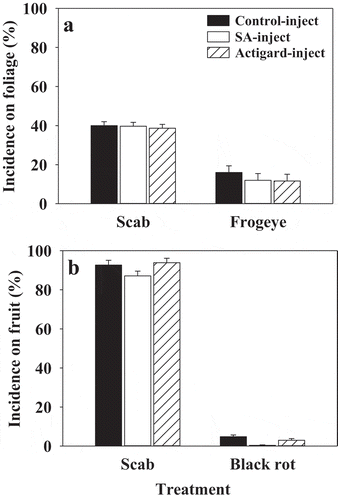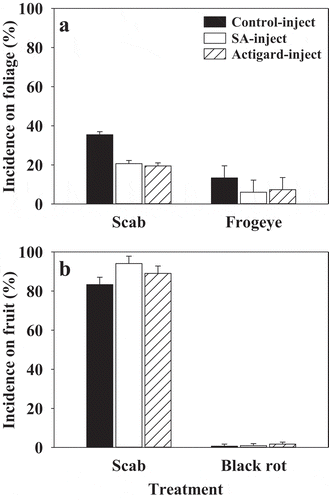Figures & data
Fig. 1 Cultivar effects on incidence of apple scab and frogeye or black rot on foliage and fruit of field-established untreated ‘Honeycrisp’ and ‘Cortland’ trees during 2014, 2015 and 2016. Mean incidence of scab and frogeye on foliage was assessed in planta three times in June at weekly intervals from 50 random leaves on each tree. The incidence of scab and black rot on fruit was determined at harvest on a whole tree basis. Means are average of three or four (2016) replicates for ‘Honeycrisp’ and two or three (2016) replicates for ‘Cortland’ and error bars represent standard error of mean.

Table 1. Main cultivar effects on incidence and severity of apple scab and incidence of frogeye on foliage of field-established treated and untreated ‘Honeycrisp’ and ‘Cortland’ trees a.
Table 2. Main cultivar effects on incidences of apple scab and black rot on fruit of field-established treated and untreated ‘Honeycrisp’ and ‘Cortland’ trees a.
Table 3. Main effects of salicylic acid (SA) and Actigard® treatments applied to field-established ‘Honeycrisp’ and ‘Cortland’ trees on apple scab and frogeye incidence on foliage a.
Table 4. Main effects of salicylic acid (SA) and Actigard® treatments applied to field-established ‘Honeycrisp’ and ‘Cortland’ trees on incidences of apple scab and black rot on fruit a.
Table 5. Effects of salicylic acid (SA) and Actigard® treatments on the incidences of apple scab and frogeye or black rot on foliage and fruit of field-established ‘Honeycrisp’ and ‘Cortland’ trees during 2014 a.
Fig. 2 Effects of salicylic acid (SA) and Actigard® injection treatments on incidence of apple scab and frogeye on foliage (a) and incidence of scab and black rot on fruit (b) of field-established ‘Cortland’ trees during 2015. Means are average of two replicates per treatment and error bars represent standard error of mean. SA (2-benzoic acid 99%; 200 mg) or Actigard® (Acibenzolar-S-methyl 50WG; 100 mg) were injected into tree trunk using an EZ-Ject Lance system. Mean incidence of scab and frogeye on foliage was assessed in planta from 50 random leaves on each tree 1, 2, and 3 weeks after the second treatment application. The incidence of scab and black rot on fruit was determined at harvest on a whole tree basis.

Fig. 3 Effects of salicylic acid (SA) and Actigard® injection treatments on incidence of scab and frogeye on foliage (a), and incidence of scab and black rot on fruit (b) of field-established ‘Cortland’ trees during 2016. Means are average of three replicates per treatment and error bars represent standard error of mean. SA (2-benzoic acid 99%; 200 mg) or Actigard® (Acibenzolar-S-methyl 50WG; 100 mg) were injected into tree trunk using an EZ-Ject Lance system. Mean incidence of scab and frogeye was assessed in planta from 50 random leaves on each tree 1, 2, and 3 weeks after the second treatment application. The incidence of scab and black rot on fruit was determined at harvest on a whole tree basis.

